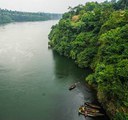
Credit: Nina R. Uganda

Credit: Nina R. Uganda

Mae Sa-Kog Ma UNESCO Man and the Biosphere Reserve near Chiang Mai, Thailand - January 2014. From January 15 to 17, USAID's Lowering Emissions in Asia's Forests project, in collaboration with the Thai Department of National Parks, Wildlife and Plant Conservation, organized a youth training camp on water quality and river ecosystem monitoring. More than 30 children from five schools in the Mae Sa Catchment area, part of the Mae Sa-Kog Ma UNESCO Man and the Biosphere Reserve near Chiang Mai, gained firsthand knowledge about riparian health and water quality testing. The Mae Sa Catchment provides valuable natural resources to surrounding communities and business operators. However, as the Reserve's resources are increasingly exploited, they are showing signs of degradation, including sedimentation and water shortages. The training built awareness and appreciation for a healthy catchment. After the training, each school will continue activities to monitor water quality and ecosystem health. Photo by Somsak Soonthornnawaphat

BOLIVIA - September 2009: Closeup of a leafcutter ant carrying a leaf. Photo by Julie Larsen Maher/ Wildlife Conservation Society (WCS)

MASAI MARA NATIONAL RESERVE, KENYA - JULY 2009. Three researchers collecting macroinverterbrates from a net at the Mara River while a Maasai Moran (Warrior) watches over them. Photo by Global Water for Sustainability



GUINEA, 2005: Farmers use an aerial map to plot agroforestry in the Nialama Classified Forest. Photo by USAID


MASAI MARA NATIONAL RESERVE, KENYA - SEPTEMBER 2009. Thousands of cattle being led by Maasai families left the Narok District and headed towards the Transmara District during the drought of 2009. Photo by Global Water for Sustainability

AMBOSELI NATIONAL PARK, KENYA - APRIL 2014: An endangered grey crowned crane in Kenya. Photo by Matthew Erdman for USAID